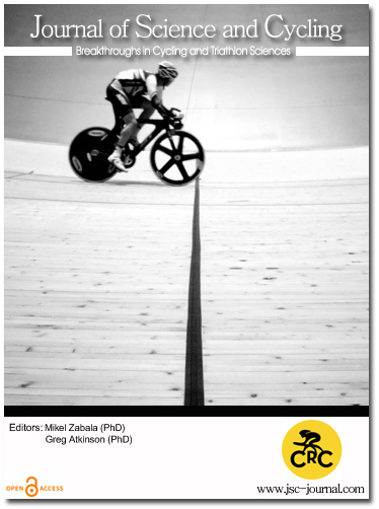Differences in power output between national and club level cyclists during a new variable power cycling test
Abstract
Background: The demands of road cycling comprise rapid and frequent variations in power output. Recently, our lab developed a 60 min variable power cycling performance test (VCT) and established its reliability for measuring power output in trained male cyclists (Sharma et al, 2014: Reliability and validity of a new variable power performance test in road cyclists, 6th Exercise and Sport Science Australia Conference, Adelaide, Australia). The VCT was modelled on data from elite men’s road racing (Ebert et al., 2006: International Journal of Sports Physiology and Performance, 1, p. 324-335) and included substantial variation in power output.Purpose: The purpose of this investigation was to determine the differences in power output between national and club level cyclists during a new test of variable cycling performance (VCT).
Methods: Nine national (N) level (mean ± s; age: 24 ± 5.2 years; mass: 71 ± 8.5 kg; peak power output: 5.3 ± 0.4 W/kg) and fourteen club (C) level cyclists (mean ± s; age: 33 ± 6.7 years; mass: 79 ± 5.5 kg; peak power output 4.6 ± 0.4 W/kg) each completed an incremental exercise test (for determination of peak power output) and a VCT (plus familiarisation). The VCT consisted of 10 x 6 min “laps”, with each lap consisting of self-paced periods where the participant were instructed to cycle at their perceived “recovery”, “hard” or “sprint” pace (figure 1). Power output was monitored continuously during the VCT.
Results: Mean power output (W/kg) for the VCT was significantly greater in N than C (mean ± s; 3.53 ± 0.24 vs. 3.18 ± 0.17; p = 0.001). Power output at each lap (figure 2) was also significantly higher in SN (p < 0.01). Relative mean power (% PPO) for sprint efforts was greater in N (mean ± s; 185 ± 29% vs. 171 ± 29%; mean difference; 14.3%, 95% CI [12.9, 15.7]) and also for “hard” efforts (mean ± s; 143 ± 13% vs. 132 ± 19%; mean difference 10.8%, 95% CI [9.7, 11.9]).
Discussion: National level cyclists were able to sustain a greater overall power output throughout the trial, as well as during sprints and hard efforts. Interestingly, the national cyclists adopted a parabolic pacing strategy, compared to the largely even pacing of the club cyclists (figure 2). Whilst both groups were able to increase power output in the latter laps, the national cyclists did so by a greater amount (figure 2). Furthermore, during the sprint and “hard” effort sections of the VCT, the national cyclists were consistently higher in power output, which may suggest an improved lactate tolerance (Coleman, 2013. In Hopker and Jobson (Eds.), Performance cycling: the science of success, 13-32. London: Bloomsbury). Thus, muscle acid/base properties associated with fatigue resistance may be highly relevant to performance during variable power cycling, including muscle buffering capacity (Chicharro et al., 2000: British Journal of Sports Medicine, 34, p. 450-455) and clearance of lactate and other metabolites (Coleman, 2013).
Conclusion: These findings suggest the VCT is a valid test of stochastic performance in trained cyclists.
Downloads
Published
How to Cite
Issue
Section
Copyright (c) 2014 Journal of Science and Cycling

This work is licensed under a Creative Commons Attribution-NonCommercial 4.0 International License.
Authors contributing to Journal of Science and Cycling agree to publish their articles under a Creative Commons CC BY-NC-ND license, allowing third parties to copy and redistribute the material in any medium or format, and to remix, transform, and build upon the material, for any purpose, even commercially, under the condition that appropriate credit is given, that a link to the license is provided, and that you indicate if changes were made. You may do so in any reasonable manner, but not in any way that suggests the licensor endorses you or your use.
Authors retain copyright of their work, with first publication rights granted to Cycling Research Center.






